Tregaron lies on the River Brenig, a tributary of the River Teifi, about nine miles north-east of Lampeter. It is an ancient market town, which served all of the rural communities locally, and was a well-known stop off on the droving route. Within the town sits the empty buildings of the now disused Tregaron County School, which is now closed and is in the process of being sold off. Inside the school are two war memorials which commemorate its former pupils who fell during both World Wars. Many of these men are commemorated on a variety of local war memorials, including several on the Tregaron War Memorial. The future of these memorials in Tregaron County School is presently unclear, but hopefully they can be moved into Tregaron Memorial Hall, alongside the town’s main war memorials.
The Great War, 1914-1918
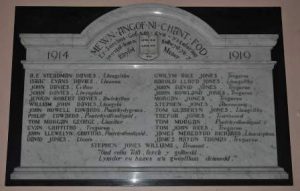
Benjamin Evan Stedman Davies, Captain, South Wales Borderers. Benjamin was the son of Peter and Mary Davies, of Caerllugest, Llangeitho. He was educated at Llangeitho and at Tregaron before gaining a position as a Clerk for the Prudential Insurance at London prior to the war. Benjamin enlisted there into the 2nd Battalion, County of London Yeomanry. Benjamin was commissioned into the 11th Battalion, South Wales Borderers on 8 May 1915. The battalion was attached to 115 Brigade, 38th (Welsh) Division, and landed in France on 3 December 1915, spending their first winter in the trenches near Armentieres. In June they marched south to the Somme, where they were tasked with the capture of Mametz Wood. The attack on the wood began on 7 July, but met with fierce resistance, and it took until 14 July to totally clear the wood. The Division suffered terrible casualties at Mametz, and were taken out of the line, and moved to Ypres to rebuild. Here they fought at the Battle of Pilckem Ridge. The Battle was launched on the morning of 31 July 1917, and the 11th South Wales Borderers were tasked with the capture of Iron Cross. The objective was captured, and the battalion had reached the Steenbeek, encamping themselves at Au Bon Gite. Benjamin, now a Captain, was reconnoitring the area, when he was shot and killed by a sniper. The 24-year-old has no known grave and is commemorated on the Ypres (Menin Gate) Memorial, Belgium. Benjamin is also commemorated on the Llangeitho war memorial.
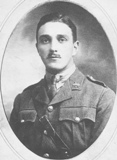
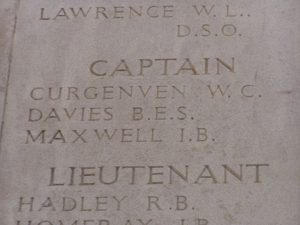
Isaac Evans Davies, Third Engineer, Mercantile Marine. Isaac was the son of John Elias Davies and Elizabeth Ann Davies (nee Evans), of Glanmorfa, Llanon. He served with the Merchant Navy aboard the S.S. Cliftondale, a Bristol registered cargo steamer. On 25 December 1917, Cliftondale was on route from Cardiff for Algiers, with a cargo of coal and general cargo, when she was torpedoed by the German submarine U-35, some 35 miles off Cape Tenes, and sank with the loss of four lives. Isaac was 21 years old when he drowned in the sinking of Cliftondale that day. He has no known grave and is commemorated on the Tower Hill Memorial, London. Isaac is also commemorated on war memorials at Llanbadarn Trefeglwys (Pennant Chapel) and in Llanon Memorial Hall.
Jenkin Robert Davies, Private, 38467, Gloucestershire Regiment. Jenkin was the son of Daniel and Jane Davies, of Lone, Bwlchyllan, Felinfach. He enlisted at Brecon into the South Wales Borderers and after completing his training was drafted to France and was transferred into the 8th (Service) Battalion, Gloucestershire Regiment, which was attached to 57 Brigade, 19th (Western) Division. Jenkin probably joined the battalion in time to take part in the Somme offensive in July 1916, where it took part in the second wave of the attack on Ovillers-La Boiselle on 1 July, capturing the village at heavy cost. It then fought through the Somme Battles of Poziéres and the Ancre in 1916. In 1917 the Division moved north to Ypres, taking part in the Battle of Messines Ridge, attacking near Oostaverne on 7 June 1917. The Division remained in the Ypres Salient after the battle and in August moved out of the line to rest and refit, before moving back into the Salient by Klein Zillebeke by 14 September. The 8th Gloucester’s moved into Beaver Camp, where it remained until 18 September, when the battalion marched out to relieve the 13th Rifle Brigade at St. Eloi. On 20 September 1917 the battalion took part in a well planned offensive here, seizing its objectives and consolidating its gains. Jenkin was among some 160 casualties suffered by the battalion when he was killed during the attack that day. The 19-year-old has no known grave and is commemorated on the Tyne Cot Memorial, Belgium. There is a separate memorial to Jenkin at Bwlchllan Methodist Chapel, whilst he is also commemorated on the Nantcwnlle war memorial.
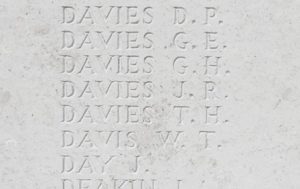
John Davies, Rifleman, 5954, London Regiment. John was the son of Evan Andrew Davies and Marie Davies, of Cnwcyfallen (formerly of Bayliau), Cellan. He resided at Crouch End, London prior to the war, and enlisted at Bunhill Row into the 21st Battalion, London Regiment (1st Surrey Rifles), which was attached to 142 Brigade, 47th (2nd London) Division. John joined the battalion in France early in 1916, north of Arras. He saw his first action here when the Germans attacked Vimy Ridge on 21 May 1916 and the Division was caught up in the heavy fighting which followed. The division remained in the sector over the coming months, and was due to move to the Somme sector in the summer. At the beginning of July 1916 the 1st Surrey Rifles were in reserve at Fosse 10, then on 16 July relieved the 17th Middlesex in the Carency support line, near Vimy Ridge. John was killed in action here during a routine spell in the trenches on 20 July 1916, just prior to the division’s move south. He was 23 years old and is buried in Louez Military Cemetery, Duisans, France. He is also commemorated on the Cellan war memorial.
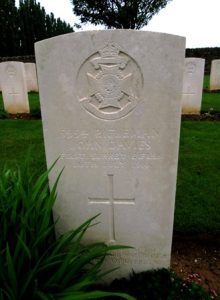
John Davies, Cadet, 175380, Royal Air Force. John was born on 5 February 1899, the son of Daniel and Elizabeth Davies, of Pencastell y Farw, Llwynpiod, Tregaron. He was educated at Tregaron before gaining a place at Aberystwyth University. John left Aberystwyth to enlist into the Royal Air Force on 4 May 1918 and was posted to RAF Uxbridge to train as a Cadet. John died during at RAF Uxbridge on 8 December 1918, after being injured in a motor car crash whilst travelling to London on leave. The remains of the 19-year-old were conveyed home and he was buried in St. Caron Churchyard Extension, Tregaron. John is also commemorated on the war memorials at Tregaron, Llangeitho and at Aberystwyth University.
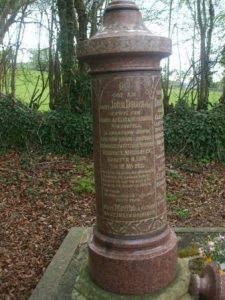
William John Davies, B.Sc., Lieutenant, Royal Garrison Artillery. William was the son of John and Louisa Hughes Davies, of School House, Llangybi. He was educated at Aberystwyth University prior to marrying Jane Hepzibah Hatton, and the couple set up home at Holmthorpe House, 1, Holmthorpe, Red Hill, Surrey, where William was a Schoolmaster. William enlisted into the Inns of Court OTC, and was commissioned on 12 November 1916, and landed in France on 27 December 1916, joining the 140th Siege Battery, Royal Garrison Artillery. William served with the Battery until being mortally wounded at Arras on 14 October 1918, dying the same day. William was 32 years old, and is buried in Bucquoy Road Cemetery, Ficheux, France. He is also commemorated on war memorials at Llangybi and at Aberystwyth University.
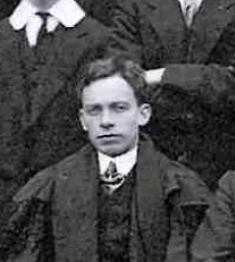
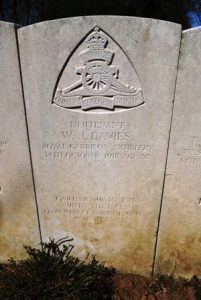
Goronwy Owen Edwards, BSc, Civilian. Goronwy was born at Corris in 1888, the son of Thomas Edwards and Elizabeth Edwards (nee Jones). He was educated at Corris Council School and at Tywyn Council School before gaining a scholarship to study at Aberystwyth University, where he gained a BSc in Chemistry. He then became assistant master at Tanygrisiau School, Ffestiniog before becoming Science Master at Tregaron County School in 1912. Following the outbreak of war, Goronwy, like many other scientists, went to work in a munitions factory. He was badly injured in an explosion early in 1917 and was sent to Burry Port Hospital to undergo operations to wounds on his face and eye. Whilst undergoing treatment at Burry Port, Goronwy, in a weakened state, caught a chill and died on 4 August 1917, aged 29. Nothing further is known of him as he is not commemorated by the CWGC. Goronwy is not named on the Tregaron County School war memorial, but as he died as a result of his work for the war effort, I have added his details here.
John Howell Edwards, Private, 28944, South Wales Borderers. John was born at Clydach Vale in 1898, the son of Samuel and Margaret Edwards. Within two years his family was residing at Penbanc, Ysbyty Ystwyth, and John was raised there. He enlisted at Brecon into the South Wales Borderers. John was posted to Egypt in 1916, joining the 4th Battalion, South Wales Borderers, which was attached to 40 Brigade, 13th (Western) Division. On 12 February 1916 the Division began to move to Mesopotamia, to strengthen the force being assembled for the relief of the besieged garrison at Kut al Amara. The relief failed, however the Mesopotamian campaign was ultimately successful. John survived the war, but died of sickness in Basra on 7 March 1919, aged 20. John is buried in Basra War Cemetery, Iraq. He is also commemorated on the war memorial at Ysbytty Ystwyth.
Phillip Edwards, Gunner, 168352, Royal Field Artillery. Phillip was the son of Rachel Edwards, of 6, Terrace Road, Pontrhydfendigaid. He worked as a collier in South Wales prior to the war and lodged at 10, Blaencwm Terrace, Treherbert. Phillip enlisted at Aberystwyth into the Royal Field Artillery soon after the outbreak of war, and was posted to France in 1916, joining the 65th Brigade, Royal Field Artillery. He took ill after about twelve months on the Western Front and was evacuated back to Britain, joining the 4th Reserve Battery, Royal Field Artillery. Phillip’s health began to deteriorate over the coming months, and he died in Nottingham Hospital of tuberculosis on 31 January 1918.The remains of the 22-year-old were brought back home and he was buried four days later in Strata Florida (St. Mary) Churchyard. Phillip is also commemorated on the war memorial at Pontrhydfendigaid.
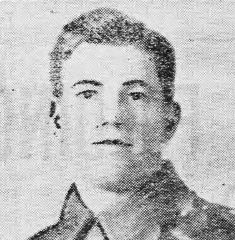
Thomas Morgan George, Private, 38483, Gloucestershire Regiment. Thomas was the son of John and Jane George, of Garthfawr, Llanilar. He enlisted at Brecon into the South Wales Borderers but was transferred to the 8th (Service) Battalion, Gloucestershire Regiment, which was attached to 57 Brigade, 19th (Western) Division, probably joining the battalion in France after the Somme Offensive had been brought to a close at the end of 1916. In 1917 the Division moved north to Ypres, taking part in the Battle of Messines Ridge, attacking near Oostaverne on 7 June 1917. The Division remained in the Ypres Salient after the battle and in August moved out of the line to rest and refit, before moving back into the Salient by Klein Zillebeke by 14 September. The 8th Gloucester’s moved into Beaver Camp, where it remained until 18 September, when the battalion marched out to relieve the 13th Rifle Brigade at St. Eloi. On 20 September 1917 the battalion took part in a well-planned offensive here, seizing its objectives and consolidating its gains. One of Thomas’s school friends from Tregaron, Jenkin Davies, of the same battalion, was killed during the attack that day. The battered battalion was relieved the following day, moving back to Beaver Camp to rest and refit. On 28 September the battalion moved back into the front line near Shrewsbury Forest and over the coming weeks the men of the battalion were kept busy on working parties, in terrible conditions. Thomas was wounded at Ypres during this period and was evacuated to hospital at Bailleul. He died of his wounds there on 23 October 1917, aged 19, and is buried in Outtersteene Communal Cemetery Extension, Bailleul, France. Thomas is also commemorated on the Llangwyryfon war memorial.
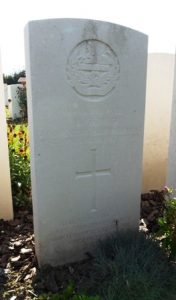
Evan Griffiths, Private, 59180, Northumberland Fusiliers. Evan was born at Llanbadarn in 1895, and was the nephew of Morgan Jones, of Bryngaron, Tregaron. He enlisted at Lampeter into the Army Service Corps, but was posted to France with the 19th Battalion, Northumberland Fusiliers, which was attached to the 35th Division as the Pioneer Battalion. The Division moved to France on 29 January 1916, and saw its first major action during the Battle of the Somme. The Division followed the German Retreat to the Hindenburg Line in March 1917. Later in the year they moved north to Ypres and fought at the Second Battle of Passchendaele, before settling down for the winter in the Salient. Following the launching of the German Offensive on the Somme on 21 March 1918, the 35th Division was hastily despatched from Ypres to the Somme sector, to bolster the battered Divisions which had been caught up in the desperate defensive actions which followed. Evan’s battalion reached Corbie by 24 March and embussed for Bray before marching to Maricourt, where the Division dug in and awaited the advancing Germans. On the following day the Germans hit the Divisions line and terrible fighting ensued, forcing the Division to slowly withdraw. Evan was killed near Dernancourt on 28 March 1918, while his battalion was gallantly defending the ruined village. The 22-year-old has no known grave and is commemorated on the Poziéres Memorial, France. Evan is also commemorated on the war memorials at Tregaron and at New Cross.
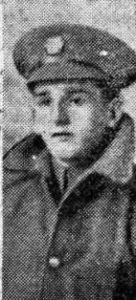
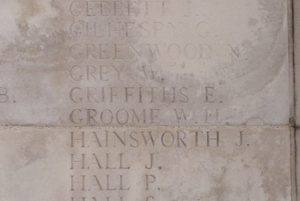
John Llewelyn Griffiths, Second Lieutenant, Northumberland Fusiliers. John was the son of William and Martha Griffiths, of 1, Turberville Road, Mount Pleasant, Porth, Rhondda. He was raised by his grandmother at 13, Terrace Road, Pontrhydfendigaid and was educated at Tregaron School. John then gained a place at Aberystwyth University, where he joined the OTC and played football for the First XI. He enlisted into the army after leaving University and was commissioned into the 15th Battalion, Northumberland Fusiliers. John was posted to France where he joined the 12th Battalion, Northumberland Fusiliers, which was attached to 62 Brigade, 21st Division. The Division landed in France between 2 and 13 September 1915, moving to positions at Loos, in reserve, but was sent into action on 26 September, suffering over 3,800 casualties. The Division rebuilt before moving to the Somme in 1916, in readiness for the launch of the Somme offensive, taking over a section of the line between the Tambour and Purfleet. John was killed on 26 June 1916 when the Germans pounded the battalions’ lines with an intense artillery bombardment, in retaliation for a trench raid. The 22-year-old was buried in Dartmoor Cemetery, Bécordel Becourt, France. John is also commemorated on the war memorials at Aberystwyth University and at Pontrhydfendigaid.
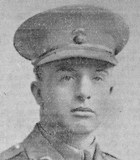
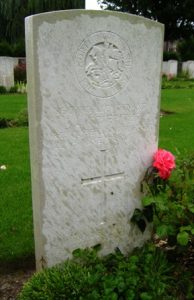
David Jones, Captain, Welsh Regiment. David was the son of Thomas and Margaret Jane Jones, of Wern Isaf, Llanddewi Brefi. He was educated at Llanddewi Brefi Council School before gaining a teacher training scholarship at Tregaron School, where he gained a reputation as a superb athlete. David then left Tregaron for Aberystwyth University, where he became a member of the OTC. He enlisted into the army straight from University, being commissioned into the 10th Battalion, Welsh Regiment. The Battalion, which was known as the 1st Rhondda Battalion, was attached to 114 Brigade, 38th (Welsh) Division. On 2 December 1915 the battalion moved to France, and the entire Division moved to the Fleurbaix sector, where it was initiated into trench warfare. During June 1916 the Division marched south to the Somme, and on 7 July 1916 attacked Mametz Wood. The initial attack failed, and it was three days later, on 10 July, that a fresh attack was mounted, with David being made second in command of the battalion for the assault. After two days of heavy hand to hand fighting within the wood, the Germans withdrew. David was killed on 12 July 1916, during the withdrawal from the wood. The 23-year-old has no known grave and is commemorated on the Thiepval Memorial, France. David is also commemorated on the war memorials at Aberystwyth University and at Llanddewi Brefi.
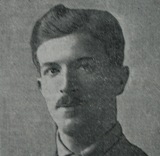
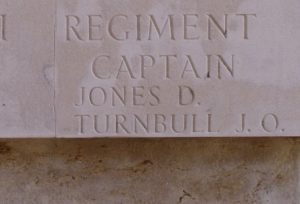
Gwilym Rice Jones, Lance Corporal, 6509, Honourable Artillery Company. Gwilym was born in 1889, the son of William and Annie Jones, of Ochor, Tregaron. He worked as a Shop Assistant at London prior to the war, and enlisted at Armoury House in November 1915, into the 3rd Battalion, Honourable Artillery Company. Gwilym was posted to France in November 1916, joining the 1st Battalion, Honourable Artillery Company, which was attached to 190 Brigade, 63rd (Royal Naval) Division. He fought with the Division during the Battle of the Ancre, and in 1917 fought throughout the Battle of Arras. On 24 November 1917, he volunteered to serve with the Royal Flying Corps and returned to Britain. He became an air cadet at RAF Wyton, where he began to train for his pilot’s licence. At 09.30 on the morning of 13 September 1918, Gwilym took off from Harling Road in an R.E.8., Serial C2484, detailed with delivering the aircraft to RAF Wyton. Gwilym had flown over 47 hours solo by now and was regarded as being of above average talent. Mysteriously his aircraft spun into a dive, and crashed at Wyton on 24 November 1918, killing Gwilym instantly. The remains of the 29-year-old were conveyed home and he was buried in Bwlchgwynt Calvinistic Methodist Chapelyard, Tregaron. Gwilym is also commemorated on the Tregaron war memorial.
Harold Lloyd-Jones, Second Lieutenant, Royal Welsh Fusiliers. Harold was born at Cardiff in 1898, the son of Harry and Maggie Lloyd-Jones. The family resided at 7, Regency Street, Westminster. Harry was educated at Llandyfriog, Tregaron and at Aberystwyth University, where he became a renowned poet. Upon graduating, Harold became a solicitor in London. He was commissioned into the Royal Welsh Fusiliers in August 1917, but resigned his commission in April 1918 after being diagnosed with heart disease. Harold died in hospital in London on 1 July 1918, aged 19. His body was brought back home by train, and he was buried in St. Tyfriog’s Churchyard, Llandyfriog three days later. Harold is also commemorated on the Aberystwyth University war memorial.
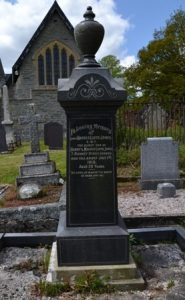
John David Jones, Private, 117652, Machine Gun Corps. John was the son of David and Rachel Jones, of 4, Brenig Terrace, Tregaron. He worked as a Tailor for his father at Tregaron prior to the war. John at Lampeter into the South Wales Borderers and married Catherine Mary Williams, a schoolteacher at Tregaron School, whilst on leave in 1916. John was then transferred to the 255th Machine Gun Company at Grantham. The Company embarked for France at Southampton on 13 November 1917 and landed at Le Havre two days later, before entraining for Mont St. Eloi, near Arras, joining the 47th (2nd London) Division. On 22 November the Company marched to Dainville and over the coming days marched to Beaulencourt, before moving from there to Beaumetz-Les-Cambrai. By now the Battle of Cambrai had begun and heavy fighting was raging along the Cambrai front, so the 255th MG Company took up positions along the Bapaume to Cambrai Road on 28 November, relieving the 201st MG Company in a ruined factory. The Company suffered heavy German artillery fire over the coming days, which knocked out several gun-crews, but held its positions, providing machine-gun fire onto positions around Bourlon Wood. John was killed in action here on 2 December 1917, whilst his Company was providing fire on Bourlon Wood. The 32-year-old has no known grave and is commemorated on the Cambrai Memorial, Louverval, France. John is also commemorated on the Tregaron war memorial.
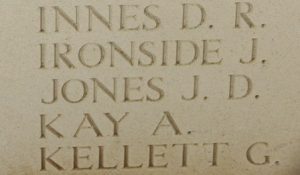
John Rowland Jones, Private, 27998, Royal Welsh Fusiliers. John was born in 1884, the son of Rees and Mary Jones, of the Emporium Shop, Tregaron. He worked as a Drapers Assistant at Tregaron before moving to London after gaining a position as a Clerk. John enlisted at Holborn into the 18th Battalion, Royal Welsh Fusiliers on 14 August 1915. He joined the battalion at Kinmel Park, where it was a reserve unit for the 38th (Welsh) Division. On 12 February 1916 John was transferred to the 22nd Battalion, Royal Welsh Fusiliers, which was another reserve unit at Kinmel Park, then was drafted to France on 14 July 1916, joining the 2nd Battalion, Royal Welsh Fusiliers, which was attached to 19 Brigade, 33rd Division. By 16 July the 2nd RWF were bivouacked in the newly captured Mametz Wood, and moved to Bazentin-le-Petit two days later, to take part in the assault on High Wood. The battalion suffered heavy casualties at High Wood, and moved back into reserve at Buire-sur-L’Ancre until 6 August and then spent several days at Becordel before moving back into the line at High Wood on 18 August, and helped beat off a German counter-attack. On 22 August 1916 the 2nd RWF moved into the support line at Bazentin-le-Grand, and six men were killed by artillery fire during their relief. During the coming weeks the 2nd RWF received several drafts of reinforcements, and on 8 December the now fully rebuilt battalion moved to new positions at Suzanne, between Bapaume and Péronne. The Division remained in this sector over the coming months, before being transferred to the Arras sector, and reached Henin by 13 April, before the Division took over a section of front line facing the Hindenburg Line. The infantry battalions of the division then began the usual routines of rotating between the front-line, support and reserve trenches and the 2nd RWF took over a position known as Tunnel Trench. On 23 April the 2nd RWF took part in a costly assault on the Hindenburg Line, suffering heavy casualties. The battered battalion then moved to a rest camp at Basseux to rebuild, and by 15 May moved back into the line in the Croisilles Sector. The Division then carried out several assaults against the Hindenburg Line, but could not breach it, so on 27 May 1917 a large-scale assault was carried out again, with the 2nd RWF in the thick of the action. John was killed in action during the assault that day. The 32-year-old has no known grave and is commemorated on the Arras Memorial, France. John is also commemorated on the Tregaron war memorial.
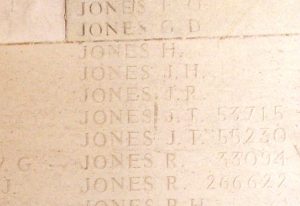
Morgan Jones, Private, 63504, South Wales Borderers. Morgan was the son of John Jones and Martha Jones, of Monarch House, Tregaron. He enlisted at Brecon into the 3rd Battalion, South Wales Borderers in 1917. The battalion was the Reserve Battalion for the 1st and 2nd Battalions, and was based at Hightown, near Liverpool, where it formed part of the Mersey Garrison. Morgan became ill whilst in training at Liverpool and was invalided to Windy Knowe VAD Hospital in Blundellsands, Liverpool for treatment. He died there of pneumonia on 5 June 1918. The remains of the 19-year-old were conveyed home and he was buried in St. Caron’s Churchyard Extension, Tregaron. Morgan is also commemorated on the Tregaron war memorial.
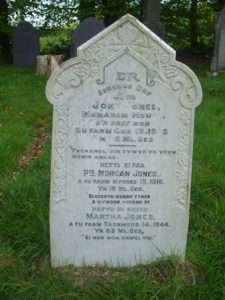
Stephen John Jones, Private, 2672, Welsh Regiment. Stephen was the son of John and Mary Jones, of Tynfronisaf, Gartheli. He left home as a young man to enlist into the Welsh Regiment in 1900 and saw action during the Second Boer War in South Africa soon afterwards, before embarking for India with the 2nd Battalion, Welsh Regiment. Stephen had left the army by 1911 and was back home working on his fathers farm, but as an army reservist was recalled to the colours following the outbreak of war and joined the 1st Battalion, Welsh Regiment following its arrival from India on 22 December 1914. The 1st Welsh then became attached to 84 Brigade, 28th Division at Hursley Park. Stephen landed at Le Havre with the 1st Welsh on 18 January 1915, and the entire 28th Division moved to Ypres, before being bussed to the Hill 60 sector, taking over trenches north of the Ypres to Lille railway by 5 February. The 1st Welsh endured a torrid six-day spell in the line before being relieved on 11 February and marched to huts at Millekapellan Farm, on the Vlamertinghe to Ouderdom Road, to rest. On 15 February the battalion marched back into the trenches and took over positions near Chateau Rosendal. The trenches were in a dire condition, knee deep in mud, with collapsing parapets, and the men worked hard to attempt to improve them over the coming days. Stephen was killed in action just a month later, when the Germans launched an attack upon these trenches on 20 February 1915. The 32-year-old has no known grave and is commemorated on the Ypres (Menin Gate) Memorial, Belgium. Stephen is commemorated on the Nantcwnlle war memorial, while there is also a memorial to him at Abermeurig Chapel.
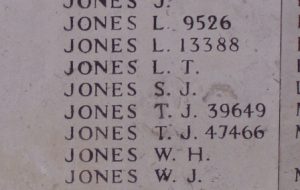
The Reverend Thomas Glasfryn Jones, Chaplain 4th Class, Army Chaplains’ Department. Thomas was born on 28 January 1884, the son of John and Mary Jones, of 3, Meidrym Road, Llangeitho. After attending Tregaron School, and studying for his B.A. at Lampeter, he graduated from St. Michael’s Theological College, Aberdare in 1906 and became Curate at Mostyn. He was offered the Curacy of Bylchau, near Denbigh but instead volunteered to serve with the Army Chaplains’ Department, and was commissioned on 3 July 1916 before landing in France on 5 July 1916, to join the 11th Battalion, South Wales Borderers, which was attached to the 38th (Welsh) Division. He was wounded near Bluet Farm on 24 March 1917 whilst attending to a wounded soldier and suffered gunshot wounds to his spine and lungs. Thomas was treated at the 46th Casualty Clearing Station at Mendinghem before being evacuated to the 7th Stationary Hospital at Boulogne. He was then brought back to England via Hospital Ship and was taken to the Empire Hospital, Vincent Square, London for treatment. Thomas died there of his wounds on 12 April 1917, aged 33. His remains were conveyed home and he was buried in St. Ceitho’s Churchyard, Llangeitho four days later. Two of his cousins were also killed: Thomas Arllwyd Jones and Stephens Jones Williams. Thomas is also commemorated on the war memorials at Llangeitho and at Lampeter College.
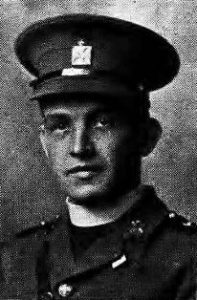
Trevor Jones, Private, 370072, Royal Army Medical Corps. Trevor was the son of Hugh and Charlotte Jones, of Broncoed, Crosswood. He enlisted at Cardiff on 7 April 1915 into the Royal Army Medical Corps, and was posted to the 53rd Welch Casualty Clearing Station, Royal Army Medical Corps, which was attached to the 53rd (Welsh) Division. The 53rd (Welsh) Division sailed from Devonport in July 1915, and arrived at Mudros on 5 August 1915. From here they moved to Gallipoli, landing on 9 August 1915. Here the Division was immediately thrown into action, and spent the next few days in isolated pockets, fighting against a Turkish counter-attack during the Battle of Sari Bair, then the ensuing Attack on Scimitar Hill. The Division remained here throughout the coming months, and suffered severe losses in manpower strength during the great November 1915 blizzard on Gallipoli, when its total strength was reduced to less than that of a full-strength Brigade. On 11 December 1915 the Division was evacuated to Mudros, and by 23 December 1915 were moved to Egypt. They remained on the Suez Canal Defences for the next twelve months, and in early 1917 moved into Palestine. Trevor was wounded and badly burnt by bombs during the First Battle of Gaza, and was evacuated to hospital at Cairo, where he died of his wounds on 13 May 1917. He was 22 years old, and is buried in Cairo War Memorial Cemetery, Egypt. Trevor is also commemorated on war memorials at Llanafan and at Tabernacl Chapel, Aberystwyth.
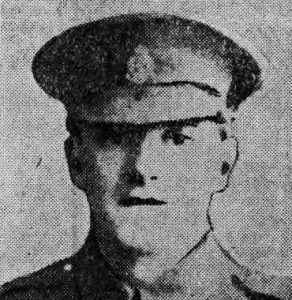
Thomas Llewelyn Jones Morgan, B.A., Lance Corporal, G/25406, Buffs (East Kent Regiment). Thomas was the son of Evan Morgan and Barbara Morgan (nee Jones), of Pretoria, Llangeitho. The family had moved to 442, Edgware Road, Marylebone prior to the war, where they ran their own dairy business. Thomas was educated at Tregaron and at Aberystwyth University before returning to London and enlisted there into the Buffs (East Kent Regiment). He was posted to France at some time in 1917, joining the 1st Battalion, The Buffs, which was attached to 16 Brigade, 6th Division. Thomas joined the battalion at Arras, where they fought at the Battle of Hill 70, and then during the Battle of Cambrai later in the year. In the spring of 1918, the Division was one of those hit by the German Offensive on the Somme, which had been launched on 21 March 1918, and the Division took part in the Battle of St Quentin. The battered Division was moved from the line, and went to Flanders to rest, but the following month the Germans launched another offensive on the Lys, and the Division became caught up in terrible fighting once more, before the Germans switched their attentions to the Champagne region at the end of May. The 6th Division remained in Flanders over the coming months, holding the Dickebusch sector. On 28 July the 1st Buffs relieved the 1st KSLI in the front-line trenches here to begin a routine tour in the line. Thomas was wounded during this spell in the line and was evacuated to the massive Casualty Clearing Station at Remy Sidings, where he died on 2 August 1918. The 19-year-old is buried in Lijssenthoek Military Cemetery, Belgium. Thomas is also commemorated on war memorials at Pontrhydfendigaid and at Aberystwyth University.
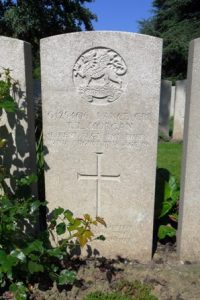
Thomas John Rees, Private, 31278, Machine Gun Corps. Thomas was the son of Thomas and Margaret Rees, of Meadow Villa, Tregaron. He was a student at Lampeter and had worked as a motor driver prior to enlisting at Lampeter into the 3rd Battalion, South Wales Borderers on 9 December 1915. Thomas then joined the battalion at Hightown, near Liverpool. On 11 April 1916 Thomas was transferred to the Machine Gun Corps and was posted to Grantham. Thomas remained at Grantham for almost a year before falling ill and was taken to Belton Park Military Hospital on 23 March 1917 where he was diagnosed as having contracted tuberculosis. He died there of tuberculosis on 8 May 1917, aged 22. Thomas’s remains were conveyed home and he was buried in Bwlchgwynt Calvinistic Methodist Chapelyard, Tregaron soon afterwards. He is also commemorated on the Tregaron war memorial.
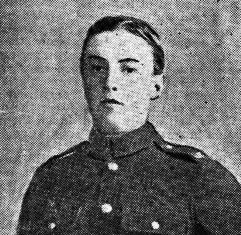
James Meredith Richards, Private, 16609, West Riding Regiment. James was the son of James Meredith Richards and Ada Janet Richards (nee McNae), of Pantyrathro, Llansteffan. He was educated at Tregaron and then at Llandovery College from 1911 to 1912, before going into business in London. In September 1914 James enlisted in the Army at Cardiff, and joined the Dragoon Guards, but was invalided home with a leg wound, and spent some time in Hospital at Manchester. On recovering from his wound, James transferred Regiments, joining the 2nd Battalion, Duke of Wellington’s (West Riding) Regiment. The Battalion was attached to 12 Brigade, 4th Division, and by the time James joined them in July 1916, they were in positions on the Somme, where they fought at the Battle of Albert and the Battle of Le Transloy. On 15 December 1916 the Battalion relieved the Essex Regiment in the front line at Bapaume, in atrocious weather conditions. It is believed that James was killed by a sniper there, on 19 December 1916. He was 22 years old, and is buried in Sailly-Saillisel British Cemetery, France. James is also commemorated on war memorials at Llansteffan, Llanybri and at Llandovery College.
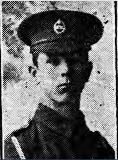
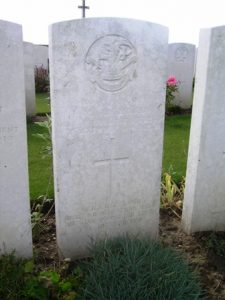
James Haydn Thomas, Private, 59302, Northumberland Fusiliers. James was the son of David Thomas and Susannah Thomas (nee James), of Cambrian House, Tregaron. He enlisted at Lampeter into the Army Ordnance Corps, but upon being drafted to France was transferred to the 25th (2nd Tyneside Irish) Battalion, Northumberland Fusiliers, which was attached to 102 Brigade, 34th Division. The Division had moved to France during January 1916, and saw its first major action on the Somme, during the Battle of Albert, where it suffered very severe casualties during its part in the attack on La Boiselle. It then took part in the Battle of Bazentin, Battle of Pozieres and the Battle of Flers-Courcelette. The following year saw them fighting at Arras, during the First and Second Battles of the Scarpe, and the Battle of Arleux. The Division wintered in the Arras Sector, in the Cojeul Valley and at the end of January 1918 had a brief spell out of the line near Hendecourt, resting and training. On 9 February the Division began moving to Ambrines, where a comprehensive training scheme was carried out before the Division moved to reserve positions at Ervillers. On 19 March 1918 the 25th Northumberland Fusiliers relieved the 9th Northumberland Fusiliers in reserve positions in front of Ervillers. At dawn on 21 March 1918 the Germans opened up a tremendous artillery barrage along a section of Western Front running south from Croisilles to La Fère, before launching an infantry assault, through thick mist, upon the British lines. The 25th Northumberland Fusiliers launched a counterattack from its support trenches upon the German infantry and became caught up in desperate fighting. James was killed in action here on 21 March 1918, aged 21. He has no known grave and is commemorated on the Arras Memorial, France. James is also commemorated on the Tregaron war memorial.
Stephen Jones Williams, Corporal, 22175, Royal Welsh Fusiliers. Stephen was the son of John and Sarah Williams, of Tanquarrel, Bronant. He lived in London prior to the war and enlisted there into the 15th Battalion, Royal Welsh Fusiliers (1st London Welsh). The battalion moved to Llandudno to join 128 Brigade, 43rd (Welsh) Division and trained in North Wales before moving to Winchester in the summer of 1915, where the formation became renumbered 113 Brigade, 38th (Welsh) Division. The Division moved to France on 2 December 1915 and moved to the Nursery Sector near Fleurbaix for trench initiation alongside the Guards Division. The Division then held a sector of the line near Cuinchy before marching south to the Somme sector in June 1916 to take part in the assault on Mametz Wood. The first attack on the wood was launched on a two-battalion front on 7 July, but failed, and the Divisional Commander, Sir Ivor Philipps, was replaced before the Division attacked again on a two Brigade front on 10 July 1916. After two days of ferocious hand-to-hand fighting, the wood was cleared up to its northern edge, before the battered Division was relieved. It then took over a section of the front at Hébuterne before moving to the Ypres Salient, and taking over the Canal Bank sector at Boesinghe. The infantry battalions of the Division then began carrying out the normal pattern of rotation in the trenches, four days in the front, four in support and four in reserve, whilst also working on trench improvement, digging new trenches, and also carrying out regular patrols and trench raids. On 31 July 1917 the Division launched its famous assault on the Pilckem Ridge, capturing Iron Cross and reaching its objective of the Steenbeek, then played a supporting role in the Battle of Langemarck. Stephen was killed in action near the Steenbeek on 4 August 1917, aged 24. He has no known grave and is commemorated on the Ypres (Menin Gate) Memorial, Belgium. Stephen is also commemorated on the Bronant war memorial.
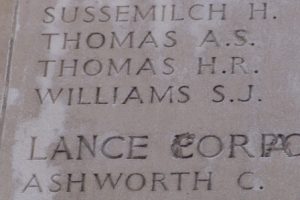
World War Two, 1939-1945
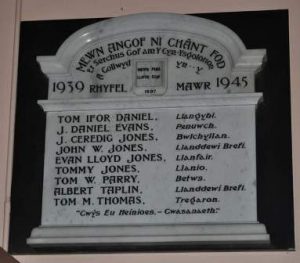
Thomas Ivor Daniel, Private, 5443862, Duke of Cornwall’s Light Infantry. Thomas was the son of John Daniel and Hannah Daniel (nee Davies), of Blaenwern Villa, Llangybi. He enlisted into the army and was posted to the 2nd Battalion, Duke of Cornwall’s Light Infantry. The Battalion was attached to the 4th Infantry Division and had been in France with the BEF in 1940. After its evacuation from Dunkirk spent almost three years in Britain before joining the Tunisian campaign in March 1943. After the surrender of the Afrika Korps moved to Italy in January 1944 and took part in the terrible fighting to drive the Germans out of the country. Thomas was killed in Italy on 8 August 1944, aged 30. He is buried in Florence War Cemetery, Italy. Thomas is also commemorated on the Llangybi war memorial.
Daniel John Evans, Gunner, 1835138, Royal Artillery. Daniel was born on 2 March 1921, and had resided at Graigwen, Penuwch. After leaving Tregaron he studied for his degree at Cardiff University. Daniel enlisted into the Royal Artillery following the outbreak of war and was posted to 239 Battery, 77 Heavy Anti-Aircraft Regiment, Royal Artillery, which was a TA unit, raised in South Wales. On 6 December 1941, the regiment sailed in Convoy WS14 from the Clyde bound for the Middle East. By the time the Convoy had reached Durban, the destination of the Regiments had been changed to Singapore, and again to Djakarta, in Java, and the Convoy reached its destination on 4 February 1942. 239 Battery moved by road and rail to Surabaja, in Eastern Java and went into action in that area in February 1942. Daniel was 21 years old when he was captured by the Japanese in Java when the garrison surrendered on 8 March 1942. He survived over two years in captivity but died as a POW at Muna Island on 20 September 1944, allegedly because of an injury suffered during an air raid. The 23-year-old was buried on Muna Island, but there are no details of his place of burial there, so he is commemorated on the Singapore Memorial, Singapore. Daniel is also commemorated on the war memorial at Penuwch Chapel, Llangeitho.
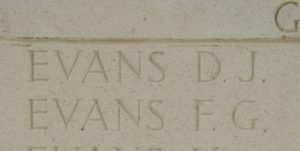
John Ceredig Jones, Sergeant, 1386043, Royal Air Force Volunteer Reserve. John was the son of John and Ellen Jones, of Parc, Nebo, Llanon. He enlisted into the Royal Air Force Volunteer Reserve and after completing his training as an Observer was posted to 158 Squadron, Royal Air Force, which was a bomber squadron, equipped with the Handley Page Halifax Mk II. On the night of 3 April 1943 John took off from RAF Lissett aboard Halifax DT795, which was part of a large bomber force bound for strategic targets in Essen. Just hours into the flight John’s Halifax was intercepted and shot down by a German night fighter, piloted by Unterofficer E. Heinzelmann, and crashed into the Apeldoorn Canal at Wapenveld, near Heerde. The bodies of three of her crew were recovered from the canal and were buried at Amersfoort, while John, who was 31 years old, and three other crew had no grave as their remains were trapped in the wreck of their aircraft. John was originally commemorated with his comrades on the Runnymede Memorial, Surrey, but in 2016 the men’s remains were found in Holland and were exhumed before being interred in Wapenveld General Cemetery, near Heerde. John’s headstone has the personal inscription: ‘YN COFIO MEWN HIRAETH A CHYDA DIOLCH AM UN A FU FARW DROS GYD-DDYN A’I WLAD’. John is also commemorated on war memorials at Aberaeron Secondary School and at Llanon Memorial Hall.

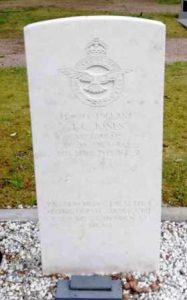
John William Jones, Lance Corporal, 6098452, Queen’s Royal Regt (West Surrey). John was the son of Morgan Jones and Margaret Jones (nee Davies), of Rock House, Cribyn. He enlisted into the army and was posted to the 1/5th Battalion, Queen’s Royal Regiment (West Surrey). The battalion was ordered overseas and fought in the Eighth Army in the Western Desert, being attached to 131 Brigade, it became the Lorried Infantry brigade of 7 Armoured Division after the Battle of El Alamein. John must have been taken prisoner by the Italians in North Africa, as he died in Italy on 24 November 1942. He was 28 years old, and is buried at Caserta War Cemetery, Italy. John is also commemorated on the Llanddewi Brefi war memorial.
Evan Lloyd-Jones, Driver, 193705, Royal Army Service Corps. Evan was born on 10 January 1915, the son of Evan Lloyd-Jones and Ellen Lloyd-Jones (nee Jenkins), of Caelleinau, Cellan. He worked as a van driver at Llanybyther prior to the war. Evan enlisted into the army and was posted to the Royal Army Service Corps, where he served as a driver. He died on active service at Wrexham on 20 April 1942, aged 27. His remains were brought home and he was buried in St. Mary’s Churchyard, Llanfair Clydogau. His brother, Benjamin Lloyd-Jones, was killed in 1941. Both brothers are commemorated on war memorials at Cellan and at Llanfair Clydogau.
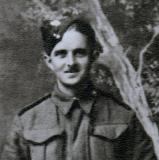
Thomas Jones, Lance Serjeant, 6144164, East Surrey Regiment. Thomas was the son of John Owen Jones and Eleanor Jones, of Wern Isaf, Llanio Road, Llanddewi Brefi. The family moved to Han-y-Bont, Morfam Llwynhendy prior to the war after his father John gained work there for the Great Western Railway. Thomas enlisted into the army and was posted to the 1/6th Battalion, East Surrey Regiment. The battalion was deployed to France at the beginning of the war and fought in Belgium and the retreat to Dunkirk, being evacuated in May 1940 and returning to England. The battalion was then rebuilt before being posted to North Africa in March 1943, to take part in the Tunisian Campaign, and was initially posted to the area around the Djebel Zebia. The battalion took part in an attack on the night of 6-7 April and over the coming days slowly advanced into enemy territory. Thomas was killed during attack on Sidi ben Touil on 13 April 1943. He was 24 years old, and is buried in Beja War Cemetery, Tunisia. Thomas is also commemorated on war memorials at Llanddewi Brefi and at Llangeitho.
Thomas Wynford Parry, Sergeant, 1381589, Royal Air Force Volunteer Reserve. Thomas was born on 21 January 1922, the son of Thomas Parry and Sarah Parry, of Brynmadog Lodge, Llangybi. He enlisted into the Royal Air Force Volunteer Reserve and was posted to 1654 Heavy Conversion Unit at RAF Swinderby, Lincolnshire. Thomas was on detachment to RAF Wittering, near Peterborough, when he died on 9 October 1942, aged 20. His remains were brought home and he was buried in St. Bledrws Churchyard, Bettws Bledrws on 16 October. Thomas is also commemorated on the Llangybi war memorial.
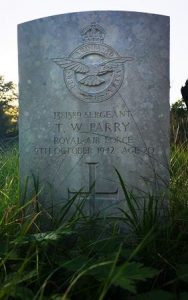
Albert Ernest William Taplin, Signalman, D/JX 144779, Royal Navy. Albert was born at Aberystwyth on 26 October 1919, the son of Ernest William Taplin and Minnie Amelia Taplin (nee Lloyd). His mother died in 1922 and his father remarried to Maria Thomas, before the family moved to Llanddewi Brefi. Albert enlisted into the Royal Navy and was posted aboard HMS Glenearn. In September 1939 Glenearn was used to carry troops and supplies to France and in October of that year was acquired by the Admiralty for conversion into a fast Fleet Supply Ship. During 1940 Glenearn was recalled to Britain and converted into an Infantry Assault Ship her lifeboats being replaced with 12 small Landing Craft, and two further 50ft Landing Craft which were launched by the derricks. Albert took ill whilst Glenearn was being refitted and died of meningitis in Walton Hospital at Liverpool on 25 December 1940. He was 21 years old and is buried in Liverpool (Anfield) Cemetery. Albert is also commemorated on the war memorial at Llanddewi Brefi.
Thomas Morgan Thomas, Flight Lieutenant, 168842, Royal Air Force Volunteer Reserve. Thomas was born at Llanelli in 1913, the son of David Daniel Thomas and Charlotte Edith Thomas (nee McLean). He lived at Tregaron prior to the war, probably working as a schoolteacher at Tregaron School, and married Rose Hannah Mathias there in 1939. Thomas enlisted into the Royal Air Force Volunteer Reserve soon after the outbreak of war and trained as a pilot before being posted to 138 Squadron, RAF. The squadron had reformed in 1941 and was the first squadron of the Royal Air Force Special Duty Service, based at RAF Stradishall. The Squadron moved to RAF Tempsford in March 1942 and carried out top secret missions, dropping supplies and agents for SIS and the SOE into Axis occupied territory. On 3 June 1944 Thomas took off from Tempsford aboard a Handley Page Halifax V, Serial LL307, which was taking part in an SOE Special Operation to drop three SOE agents into Belgium. The Halifax was intercepted by a German night-fighter and was shot down soon after crossing the Channel into Holland and crashed near Stavenisse on Tholen Island, killing Thomas and his entire crew. Thomas was 31 years old when he died in the crash that night and is buried alongside his crew in Bergen-op-Zoom War Cemetery, Netherlands.